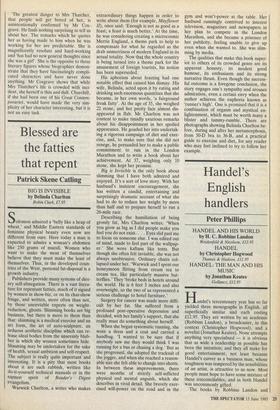Blessed are the fatties that repent
Patrick Skene Catling
BIG IS INVISIBLE by Belinda Charlton
Robin Clark, £7.95
Solomon admired a 'belly like a heap of wheat,' and Middle Eastern standards of feminine physical beauty even now are different from ours. Here today a man is expected to admire a woman's abdomen like 250 grams of muesli. Women who want to make the most of themselves believe that they must make the least of themselves. Thus, in the developed coun- tries of the West, personal fat-disposal is a growth industry.
Publishers provide many systems of diet- ary self-abnegation. There is a vast litera- ture for repentant fatties, much of it signed by women in show-biz, or on its chat-show fringe, and written, more often than not, by those unenviable experts on weight- reduction, ghosts. Slimming books are big business, but there is more to them than that: slimming is a medical exercise and an art form, the art of auto-sculpture, an arduous aesthetic discipline which can re- lease ideal bodies from the xinseemly blub- ber in which shy women sometimes hide. Slimming may be undertaken for the sake of health, sexual ambition and self-respect. The subject is really quite important and Interesting. It is a pity that most books about it are such rubbish, written like do-it-yourself technical manuals or in the earnest spirit of Reader's Digest evangelism.
Warwick Charlton, a writer who makes extraordinary things happen in order to write about them (for example, Mayflower II), once said: 'Enough is not as good as a feast; a feast is much better.' At the time, he was considering creating a microcosmic Merrie England, a theme park to help to compensate for what he regarded as the drab unmerriness of modern England in its actual totality. Now that the whole country is being turned into a theme park for the amusement of foreign tourists, his notion has been superseded.
His aphorism about feasting had one notable effect that caused him dismay. His wife, Belinda, acted upon it by eating and drinking such enormous quantities that she became, in her own words, 'a fairground freak fatty'. At the age of 35, she weighed 22 stone, and her pretty face almost dis- appeared in flab. Mr Charlton was not content to make timidly uxurious remarks about his disappointment in her spoiled appearance. He goaded her into undertak- ing a rigorous campaign of diet and exer- cise, and, to make sure that she did not renege, he persuaded her to make a public commitment to run in the London Marathon and to write a book about her achievement. At 37, weighing only 10 stone, she kept her promise.
Big is Invisible is the only book about slimming that I have both admired and enjoyed. It's a sort of love story. With her husband's insistent encouragement, she has written a candid, entertaining and surprisingly dramatic account of what she had to do to reduce her weight by more than half and to prepare herself to run a 26-mile race.
Describing the humiliation of being grossly fat, Mrs Charlton writes: 'When you grow as big as I did people make you feel you do not exist.. . . Eyes slid past me to focus on someone else. I was edited out of mind, made to feel part of the wallpap- er.' She wore kaftans like tents. But though she often felt invisible, she was not always unobtrusive. Ordinary chairs col- lapsed under her. 'Warwick and I spent our honeymoon flitting from cream tea to cream tea, like particularly massive but- terflies.' They 'broke beds in hotels around the world. He is 6 feet 3 inches and also overweight, so the two of us represented a serious challenge to hotel furniture.'
Surgery for cancer was made more diffi- cult by her fat. She suffered from a profound post-operative depression and decided, with her family's support, that she really must do something about herself.
When she began systematic running, she wore a dress and a coat and carried a handbag. 'I wanted to be sure that if anybody saw me they would think I was running for a bus or chasing a dog.' But as she progressed, she adopted the tracksuit of the jogger, and when she reached a reason- able size she felt able to change into shorts. In between these improvements, there were months of strictly self-inflicted physical and mental anguish, which she describes in vivid detail. She bravely exer- cised will-power on the road and in the gym and won't-power at the table. Her husband cunningly contrived to interest television, magazines and newspapers in her plan to compete in the London Marathon, and she became a prisoner of her publicity, feeling unable to give up even when she wanted to. She was slim- ming by media.
The qualities that make this book super- ior to others of its crowded genre are its apparent honesty, its modest good humour, its enthusiasm and its strong narrative thrust. Even though the success- ful outcome is a foregone conclusion, the story engages one's sympathy and arouses admiration, even a certain envy when the author achieves the euphoria known as 'runner's high'. One is promised that it is a combination of orgasm and mystical en- lightenment, which must be worth many a blister and tummy-rumble. There are photographs showing Belinda Charlton be- fore, during and after her metamorphosis, from 50-D bra to 36-B, and a practical guide to exercise and diet, for any reader who may feel inclined to try to follow her example.


















































 Previous page
Previous page